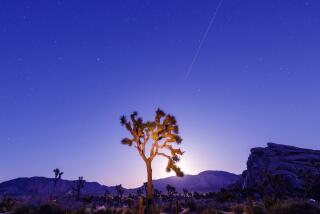Harvest moon tonight: Celebrate with video of moon’s hidden side
Happy harvest moon!
Wednesday night’s full moon is known as the harvest moon because it is the closest full moon to the fall equinox, which occurs Sunday and will mark the official start of autumn.
The equinox happens twice a year, once in the spring and once in the fall, when the Earth isn’t tilted toward the sun or away from it. On those days, the length of day and the length of night are almost exactly the same across the planet.
PHOTOS: Amazing moons of the solar system
There is nothing about the harvest moon itself that makes it different from any other full moon -- it isn’t bigger or brighter, or more orange -- but it does appear to stick around longer.
Because of the tilt of the moon’s orbit in September, the moon rises at about the same time that the sun is setting for a few days after the full moon. Usually the moon rises at sunset only on the day it is full and then rises about an hour later each subsequent day, says Steve Edberg, an astronomer at the Jet Propulsion Laboratory.
“People are more likely to notice it because it has this effect that looks like it hasn’t really changed positions, and it seems like it is hanging around a lot longer,” he told the Los Angeles Times in 2011.
In Southern California, you can look for the harvest moon to rise at 6:22 p.m. PDT, according to the Griffith Observatory moonrise and moonset chart.
In the meantime, check out the amazing time-lapse video above, which allows you to see the moon as you’ve never seen it before.
Because the moon is tidally locked to Earth, the same side faces us at all times. But thanks to NASA’s Lunar Reconnaissance Orbiter, this video lets us see almost the entire surface of the moon as it rotates before our eyes.
Thank you, NASA, and happy harvest moon viewing!
If you’re interested in the moon, you’re interested in what I write about. Follow me on Twitter.
ALSO:
The world is slightly happier than it used to be
When Sutter’s Mill meteorite split open, out fell seeds of early life
How a comet impact may have jump-started life on Earth -- and elsewhere







